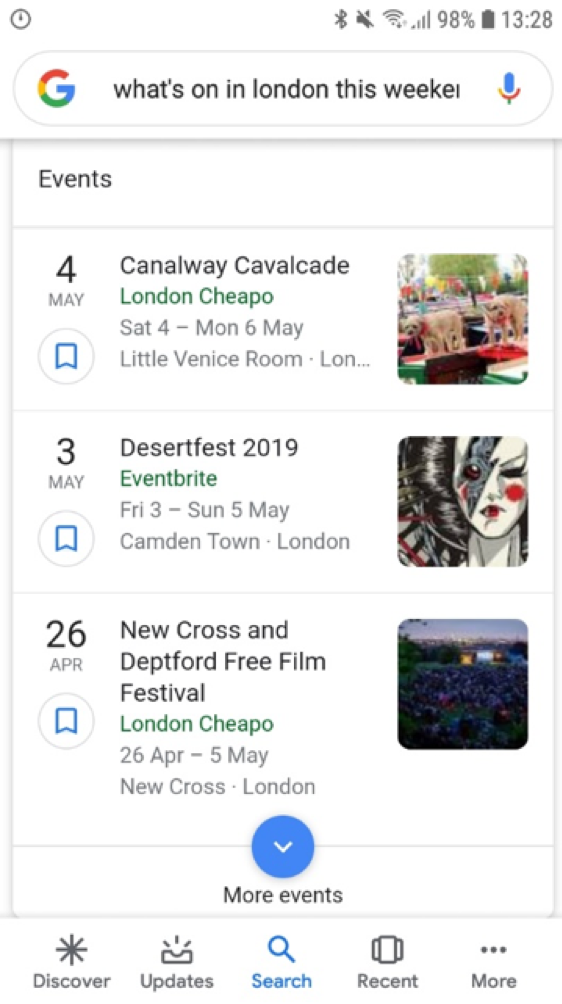What is structured data
Structured data is the term used for any information contained on a webpage that fits a format. Essentially it is data that has structure, for instance, tables or graphs. Within the context of SEO it is often used interchangeably with schema mark-up. This is the process of labelling the data in such a way as to give the search engines additional context of what the data relates to.
How structured data displays in search engines
One major benefit of structured data is that it allows search engines to display content in the SERPs in a more attractive and eye-catching way for users. The schema used gives the search engines reassurance that the data means what they think it means and therefore they can display it in rich formats with more certainty.
Google in particular has four main types of results, all of which are either enhanced by mark-up or rely on it entirely:
Basic results – Often called “plain blue links” these are the traditional organic search listings we are all familiar with. A title, description and URL to click through to.
Rich results – these are results that includes styling, images, and other features. Commonly seen in searches for products, films and books.
Enriched search results – A more feature-rich version of the rich results these allow for some interaction.
Knowledge panel – this result contains information gathered from multiple sources on the web and displayed in a visually engaging way, similar to the rich results.[1]
Featured snippets – the organic search result that sites above the rest of the basic results and directly answers a query pulling data from a ranking web-page, usually displaying the answer in table, paragraph or list form.
How user intent influence results
Experts will often tell you that the key to a good marketing campaign is understanding a user’s needs. There is no difference with SEO. Google and the other search engines have to understand what the context and implication of a searcher’s query is in order to ensure they are delivering results that will satisfy that query.
This is key to ensuring your use of structured data maximises your chances of getting a click-through, lead or brand awareness for your website.
Take a simple search query, like “penguins”. Currently, when searched, the results returned by Google UK feature a webpage about the species of bird in position 1, the Pittsburgh Penguins in a carousel of Twitter tweets after that, information about the film “Penguins” at the bottom of the first page, followed by a page about the book publishers. In position 22 there is even a page about the Google algorithm update of the same name. This gives a good indicator of how Google deals with an ambiguous query – it hedges its bets by including resources that would satisfy several query intents.
So how do these two combine to make a winning SEO strategy?
When you are looking to enhance your website using structured data it is important to understand what keywords your page might rank for and what the user’s intent might be behind that query. For instance, if your page is displayed for the search query “garden sheds for sale” the intent is fairly obvious. It would be reasonable to assume a searcher using this keyword phrase would be after a webpage that gives them information on garden sheds they can buy. The key to maximising your use of structured data in this instance is to consider what schema mark-up the search engines currently use to display results for queries with a purchase intent.
If we search “garden sheds for sale” we can see search results with a variety of schema powered enrichments. This example below shows the use of product schema to mark-up reviews, stock price range and if the items are in stock.

From this analysis you can have a better gauge of what structured data Google might honour by displaying it in the search results. It would be prudent from this to include that schema on your page.
You may discover that your competitors aren’t harnessing the power of schema yet, which could give your site a great advantage, but doesn’t help you in assessing what schema Google might use in its search results.
This is where your identification of the users’ intent is key. Using schema.org’s website to see what mark-up is available, consider what format and type of information your audience will be looking for when searching on the keywords you have optimised your site for.
It may be a long case of trial and error to see what mark-up Google will present in the SERPs but once you have found it your search results will instantly stand-out from your competition’s.
Oncrawl SEO Crawler
Content types
The way to maximise clicks-through with mark-up for my previous example is fairly obvious, searchers looking for products will likely want to know more about the products available before clicking through to the site to view them. But what about other search intents?
As previously mentioned, there are a whole host of other search result types used by Google that can be triggered depending on the user’s query. Below I’m going to look at a few types of content that lend themselves to appearing in these special results formats and give some tips on how to use these to capitalise on searcher intent.
Jobs
Recruitment is hard and can often be costly. If you are looking to get your vacancy seen by candidates without incurring the fees of a recruiter or job board then Google’s Job Search Results is a great feature to use.
Most candidates are looking for similar information – the location of the role, remuneration, and if the role is full or part-time. All this information can be pulled through and displayed by Google from your website if you are using the right structured data mark-up correctly. Google’s page on Job Posting gives more guidance on how to implement the mark-up.
Instructions
Anyone who has been caught desperately “Googling” for how to fix a burst pipe or how to change a tyre knows that trawling through search results looking for the answer is not desirable. Google knows this too, which is why featured snippets/position 0/answer box (yes, it has a lot of names) is becoming so widely used in the search results. These results are also what often powers the answers from smart assistants like Google Home.
The key to appearing in these coveted spots above the first normal organic result is to use structured data in its purest sense. No need to mark-up your data for this one, simply structure it in a way that lends itself to answering a question.
Tables, numbered lists, video guides: these all provide quick answers to questions that users may search when needing instructions. The best way to ensure that your webpage still gets a click when it is displayed as a featured snippet is to organise your data in such a way that it is not displayed in its entirety when presented in the snippet. For example, if you get a featured snippet ranking for a list of steps, then make sure you include enough steps in your content that at least one or two of them are not displayed in the snippet. Keeping in mind that the user has searched for this information and been presented with a step-by-step guide they are likely going to want to see all of the steps and therefore will need to click through to your webpage to see the final ones. From there you can use your amazing conversion rate optimisation to funnel them through your website.
Events
Using event schema enables your event to be displayed at the top of the search results when users are looking for events like yours on their mobile devices. For instance, “what’s on in London this weekend” displays the following:

Personal profile
An often-overlooked use for schema mark-up is one that is very useful for building personal brand. If you are a freelancer or industry professional looking to increase your own exposure, then including mark-up to describe attributes about yourself will help your profile to appear in the search results. You can mark up your social profiles, date of birth, home town – a whole host of properties. All of these have the propensity to be pulled through to the search results and displayed in a card. Using the attribute “sameAs” allows the search engines to understand your website profile’s relationship to other entities like your Twitter and LinkedIn profiles. All of this combines to give you greater visibility in the search results.
Think about what a prospective client may want to know about you – are credentials and qualifications important in your industry? Are the awards you’ve won or schools you’ve attended a deciding factor? The schema.org list for person mark-up is extensive. The more you use of the mark-up, the more the search engines can display in the SERPs with confidence. There’s no way to force Google to display this information in a Knowledge Panel, it needs to think you are notable enough to warrant one, but this sort of mark-up can help it join the dots of your online presence and hopefully highlight just how noteworthy you are!
Conclusion
So, how does user intent and structured mark-up combine to make a winning strategy? You are giving the search engines the certainty that the information you want them to display to your information-hungry audience is accurate and relevant. Once you know what your audience wants you are spoon-feeding Google the information it needs to satisfy those queries in a format that gives it certainty over the relevance and accuracy of the information. From there, watch the ways your information is displayed in attention-grabbing formats straight in the SERPs.

